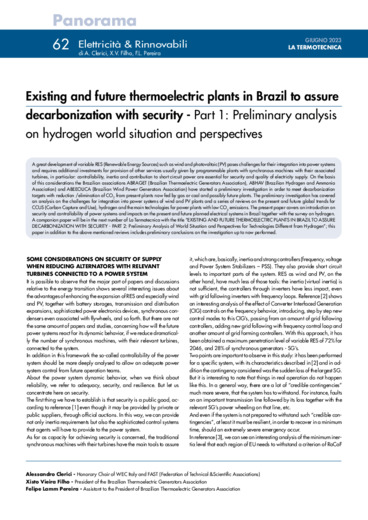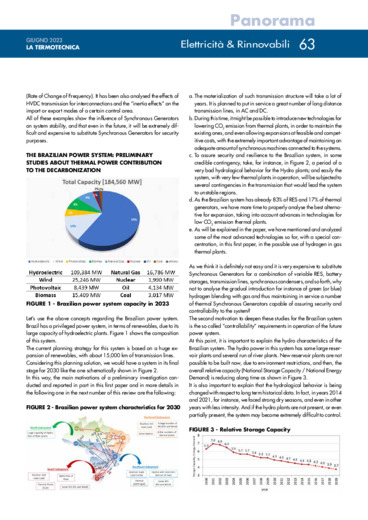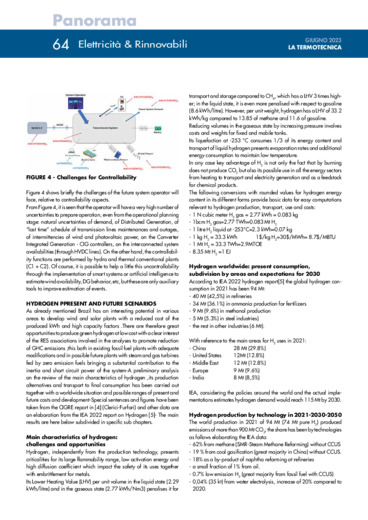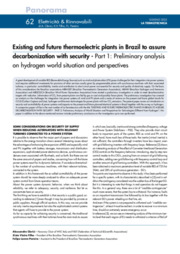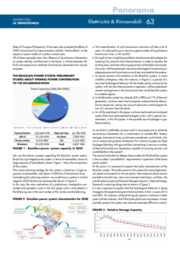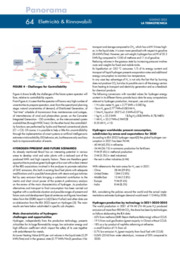Existing and future thermoelectric plants in Brazil to assure decarbonization with security
La Termotecnica
 Segui
SeguiPart 1: Preliminary analysis on hydrogen world situation and perspectives
(in lingua inglese)
A great development of variable RES (Renewable Energy Sources) such as wind and photovoltaic (PV) poses challenges for their integration into power systems and requires additional investments for provision of other services usually given by programmable plants with synchronous machines with their associated turbines, in particular: controllability, inertia and contribution to short circuit power are essential for security and quality of electricity supply.
On the basis of this considerations the Brazilian associations ABRAGET (Brazilian Thermoelectric Generators Association), ABHAV (Brazilian Hydrogen and Ammonia Association) and ABEEOLICA (Brazilian Wind Power Generators Association) have started a preliminary investigation in order to meet decarbonization targets with reduction /elimination of CO2 from present plants now fed by gas or coal and possibly future plants.
The preliminary investigation has covered an analysis on the challenges for integration into power systems of wind and PV plants and a series of reviews on the present and future global trends for CCUS (Carbon Capture and Use), hydrogen and the main technologies for power plants with low CO2 emissions.
The present paper covers a introduction on security and controllability of power systems and impacts on the present and future planned electrical systems in Brazil together with the survey on hydrogen.
A companion paper will be in the next number of La Termotecnica with the title "EXISTING AND FUTURE THERMOELECTRIC PLANTS IN BRAZIL TO ASSURE DECARBONIZATION WITH SECURITY - PART 2: Preliminary Analysis of World Situation and Perspectives for Technologies Different from Hydrogen"; this paper in addition to the above mentioned reviews includes preliminary conclusions on the investigation up to now performed.
Some considerations on security of supply when reducing alternators with relevant turbines connected to a power system
It is possible to observe that the major part of papers and discussions relative to the energy transition shows several interesting issues about the advantages of enhancing the expansion of RES and especially wind and PV, together with battery storages, transmission and distribution expansions, sophisticated power electronics devices, synchronous condensers even associated with flywheels, and so forth.
But there are not the same amount of papers and studies, concerning how will the future power systems react for its dynamic behavior, if we reduce dramatically the number of synchronous machines, with their relevant turbines, connected to the system.
In addition in this framework the so-called controllability of the power system should be more deeply analysed to allow an adequate power system control from future operation teams. About the power system dynamic behavior, when we think about reliability, we refer to adequacy, security, and resilience. But let us concentrate here on security.
The first thing we have to establish is that security is a public good, according to reference [1] even though it may be provided by private or public suppliers, through official auctions. In this way, we can provide not only inertia requirements but also the sophisticated control systems that agents will have to provide to the power system.
As far as capacity for achieving security is concerned, the traditional synchronous machines with their turbines have the main tools to assure it, which are, basically, inertia and strong controllers (frequency, voltage and Power System Stabilizers - PSS).
They also provide short circuit levels to important parts of the system. RES as wind and PV, on the other hand, have much less of those tools: the inertia (virtual inertia) is not sufficient, the controllers through inverters have less impact, even with grid following inverters with frequency loops.
Reference [2] shows an interesting analysis of the effect of Converter Interfaced Generation (CIG) controls on the frequency behavior, introducing, step by step new control modes to this CIG's, passing from an amount of grid following controllers, adding new grid following with frequency control loop and another amount of grid forming controllers.
With this approach, it has been obtained a maximum penetration level of variable RES of 72% for 2046, and 28% of synchronous generators - SG's. Two points are important to observe in this study: it has been performed for a specific system, with its characteristics described in [2] and in addition the contingency considered was the sudden loss of the largest SG.
But it is interesting to note that things in real operation do not happen like this. In a general way, there are a lot of "credible contingencies" much more severe, that the system has to withstand. For instance, faults on an important transmission line followed by its loss together with the relevant SG's power wheeling on that line, etc.
And even if the system is not prepared to withstand such "credible contingencies", at least it must be resilient, in order to recover in a minimum time, should an extremely severe emergency occur.
In reference [3], we can see an interesting analysis of the minimum inertia level that each region of EU needs to withstand a criterion of RoCoF (Rate of Change of Frequency). It has been also analysed the effects of HVDC transmission for interconnections and the "inertia effects" on the import or export modes of a certain control area.
All of these examples show the influence of Synchronous Generators on system stability, and that even in the future, it will be extremely difficult and expensive to substitute Synchronous Generators for security purposes.
The Brazilian power system: preliminary studies about thermal power contribution to the decarbonization
Let's use the above concepts regarding the Brazilian power system. Brazil has a privileged power system, in terms of renewables, due to its large capacity of hydroelectric plants. Figure 1 shows the composition of this system. The current planning strategy for this system is based on a huge expansion of renewables, with about 15,000 km of transmission lines.
Considering this planning solution, we would have a system in its final stage for 2030 like the one schematically shown in Figure 2. In this way, the main motivations of a preliminary investigation conducted and reported in part in this first paper and in more details in the following one in the next number of this review are the following:
a. The materialization of such transmission structure will take a lot of years. It is planned to put in service a great number of long distance transmission lines, in AC and DC.
b. During this time, it might be possible to introduce new technologies for lowering CO2 emission from thermal plants, in order to maintain the existing ones, and even allowing expansions at feasible and competitive costs, with the extremely important advantage of maintaining an adequate amount of synchronous machines connected to the systems.
c. To assure security and resilience to the Brazilian system, in some credible contingency, take, for instance, in Figure 2, a period of a very bad hydrological behavior for the Hydro plants; and easily the system, with very few thermal plants in operation, will be subjected to several contingencies in the transmission that would lead the system to unstable regions.
d. As the Brazilian system has already 83% of RES and 17% of thermal generators, we have more time to properly analyse the best alternative for expansion, taking into account advances in technologies for low CO2 emission thermal plants.
e. As will be explained in the paper, we have mentioned and analyzed some of the most advanced technologies so far, with a special concentration, in this first paper, in the possible use of hydrogen in gas thermal plants.
As we think it is definitely not easy and it is very expensive to substitute Synchronous Generators for a combination of variable RES, battery storages, transmission lines, synchronous condensers, and so forth, why not to analyse the gradual introduction for instance of green (or blue) hydrogen blending with gas and thus maintaining in service a number of thermal Synchronous Generators capable of assuring security and controllability to the system?
The second motivation to deepen these studies for the Brazilian system is the so called "controllability" requirements in operation of the future power system. At this point, it is important to explain the hydro characteristics of the Brazilian system. The hydro power in this system has some large reservoir plants and several run of river plants.
New reservoir plants are not possible to be built now, due to environment restrictions, and then, the overall relative capacity (National Storage Capacity / National Energy Demand) is reducing along time as shown in Figure 3. It is also important to explain that the hydrological behavior is being changed with respect to long term historical data.
In fact, in years 2014 and 2021, for instance, we faced strong dry seasons, and even in other years with less intensity. And if the hydro plants are not present, or even partially present, the system may become extremely difficult to control. Figure 4 shows briefly the challenges of the future system operator will face, relative to controllability aspects.
From Figure 4, it is seen that the operator will have a very high number of uncertainties to prepare operation, even from the operational planning stage: natural uncertainties of demand, of Distributed Generation, of "last time" schedule of transmission lines maintenances and outages, of intermittencies of wind and photovoltaic power, on the Converter Integrated Generation - CIG controllers, on the interconnected system availabilities (through HVDC lines).
On the other hand, the controllability functions are performed by hydro and thermal conventional plants (C1 + C2). Of course, it is possible to help a little this uncontrollability through the implementation of smart systems or artificial intelligence to estimate wind availability, DG behavior, etc, but these are only auxiliary tools to improve estimation of events.
Attached, you can download the full pdf of the article.
Settori: , , , , , ,
Parole chiave: , , , , ,





